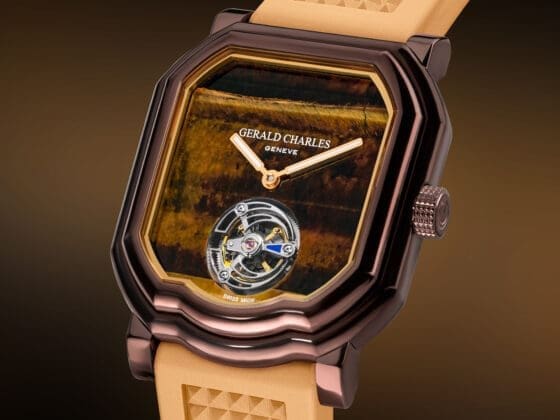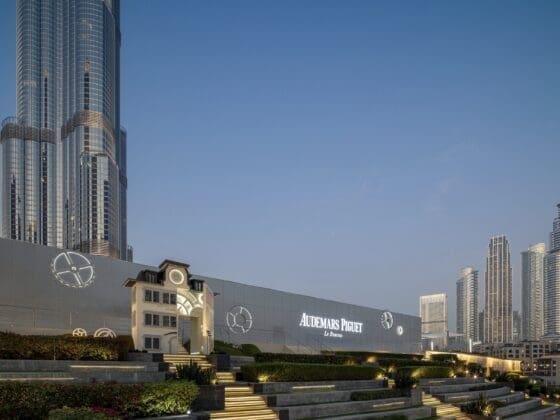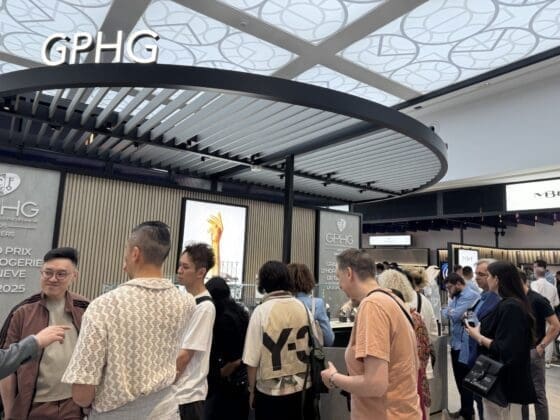In the mid-1960s, architecture entered an experimental phase in stark contrast to the pragmatic, rectilinear forms of Post-war buildings. The new movement was humanist in the sense that it moulded space inspired by the form of the human body. These architects, who preferred to call themselves habitologists, built houses which appeared as if they had been exhaled out of the earth; they bubbled, they undulated, and they arched like an extended sinew.
And when Maximilian Büsser, founder of MB&F, looked at one of these houses, a thought pooped into his creative mind: “What if that house was a watch?” MB&F’s newest timepiece – Horological Machine Nº11 Architect – could therefore be best described as the house that Max built.

The first blueprints for HM11 were made in 2018 by Eric Giroud, the principal designer at MB&F. His architectural background clearly informs the layout of the timepiece. A central atrium that gives onto four peripheral rooms, transparency and light, interior volumes that interact with exterior perspectives, and curvilinear morphology.
A central flying tourbillon forms the heart of the “house,” pushing skyward under a double-domed sapphire roof. Its quatrefoil-shaped upper bridge recalls the shape of clerestory windows. From this spinning core, four symmetrical volumes reach outwards, creating the four parabolic “rooms” of the house.
To access each room while on the wrist, the entire structure rotates on its foundations. Each 45° clockwise turn is signalled by a tactile click under the fingers, and delivers 72 minutes of power directly to the barrel. After 10 complete rotations, HM11 is at its maximum reserve of 96 hours.

While all four rooms share a similar interior – glossy white walls with a full sapphire crystal window pane – each of them has a different function. The time room displays the hours and minutes. Rod-mounted orbs serve as hour markers, using larger and lighter polished aluminium orbs for each quarter and smaller and darker polished titanium orbs for the rest. Red-tipped arrows point to the hours and minutes, providing a rare accent of colour to the otherwise Spartan time room.
The next room displays the power reserve. Following the design schema established by the time room, rod-mounted orbs are paired with a red-tipped arrow to show how much power is left in the barrel. Proceeding clockwise, the five orbs increase in diameter until the final polished aluminium orb, 2.4mm in diameter, indicating the full 96 hours of power reserve.

In the third room is an instrument rarely seen in horological contexts – a thermometer. HM11 uses a mechanical system of temperature indication with a bimetallic strip. This mechanical system functions without any external energy input and is available in Celsius or Fahrenheit display variations.
The last room is a white void with a tiny round badge engraved with the MB&F battle-axe motif. This seemingly empty space functions as the time-setting crown of HM11. When the transparent sapphire module is pulled, it opens with a click.

The rooms of HM11 are surrounded by exterior walls of polished grade-5 titanium. The central atrium is open to the light, covered by a double-arched sapphire crystal roof. Plates and bridges are coloured with a physical vapour deposition (PVD) process, coming in ozone blue or the warm solar hues of 5N gold.
Underneath, the in-house HM11 engine hums away, its cadence set by the 2.5Hz (18,000 vph) balance of the flying tourbillon. Rather than applying additional shock-proofing elements to individual watch components, HM11 incorporates a full-system dampener, consisting of four high-tension suspension springs that sit between the movement and lower-case shell.
These are custom springs laser-cut out of a low-carbon high-hardness steel tube with a chrome finish. The specific alloy composition and crystalline structure of this steel – derived from the aerospace industry – provide exceptional resistance to wear, while its finish and cylindrical form impart aesthetic value.

The lower half of the HM11 case is a highly three-dimensional Grade-5 titanium shell with different inner and outer surface profiles. The upper caps of each of the four HM11 rooms are machined separately since they can be affixed only after the movement has been installed. Close to a week is required to complete the HM11 case, comprising all the operations of milling, finishing and quality control.
The Horological Machines of MB&F have established a reputation for increasing the sophistication of shaped sapphire crystal components used in watchmaking, and Horological Machine Nº11 is no exception. There are six externally facing sapphire crystal components in the case of HM11, the largest of which consists of two separate sapphire crystal domes stacked concentrically to form the transparent “atrium roof” of HM11.
The unprecedented feature, however, is the see-through sapphire crown. Close to 10mm in diameter, it allows a view directly into the movement. A conventional gasket sized in proportion to a crown of this size in sapphire crystal would have been unusable. Instead, a total of 8 gaskets in two layers are used to seal the crown aperture from dust and moisture. The case itself is watertight up to 2ATM or 20 metres.

Despite its 3-dimensional, architectural conception and the complexity of its movement, the HM11 case measures only 42mm in diameter. It sits sleekly and comfortably on the wrist, thanks to the curved case feet that are also the strap attachment points. These allow the watch to fit a variety of wrist sizes, while also providing stability when the case is turned to wind the barrel.
HM11 is fastened with a rubber strap – white for the blue model and khaki green for the red-gold model. Both have titanium tang buckles. Both of these two launch editions of HM11 are limited to 25 pieces each.









